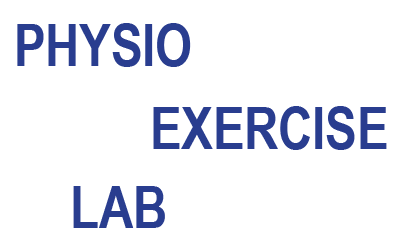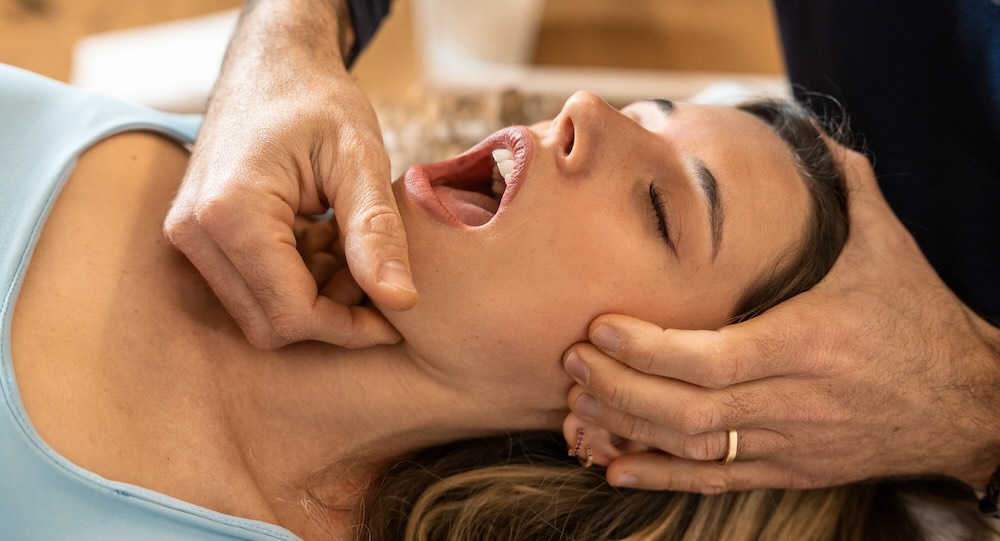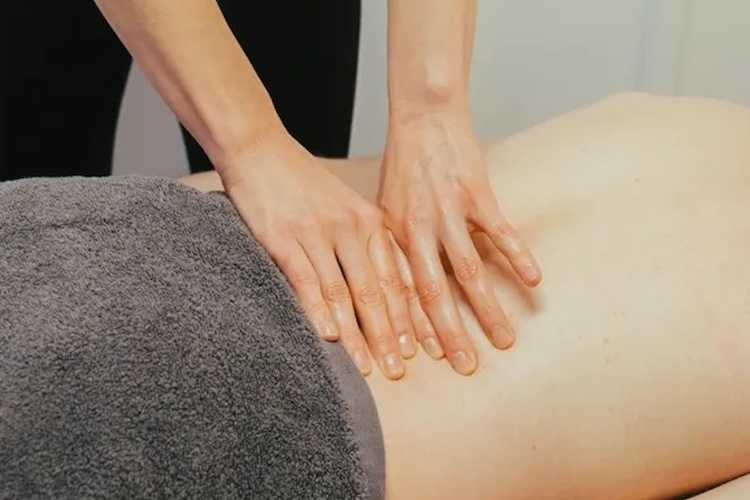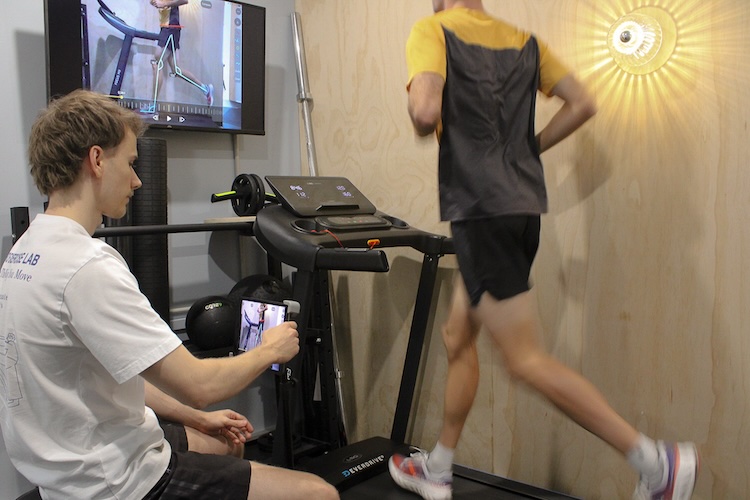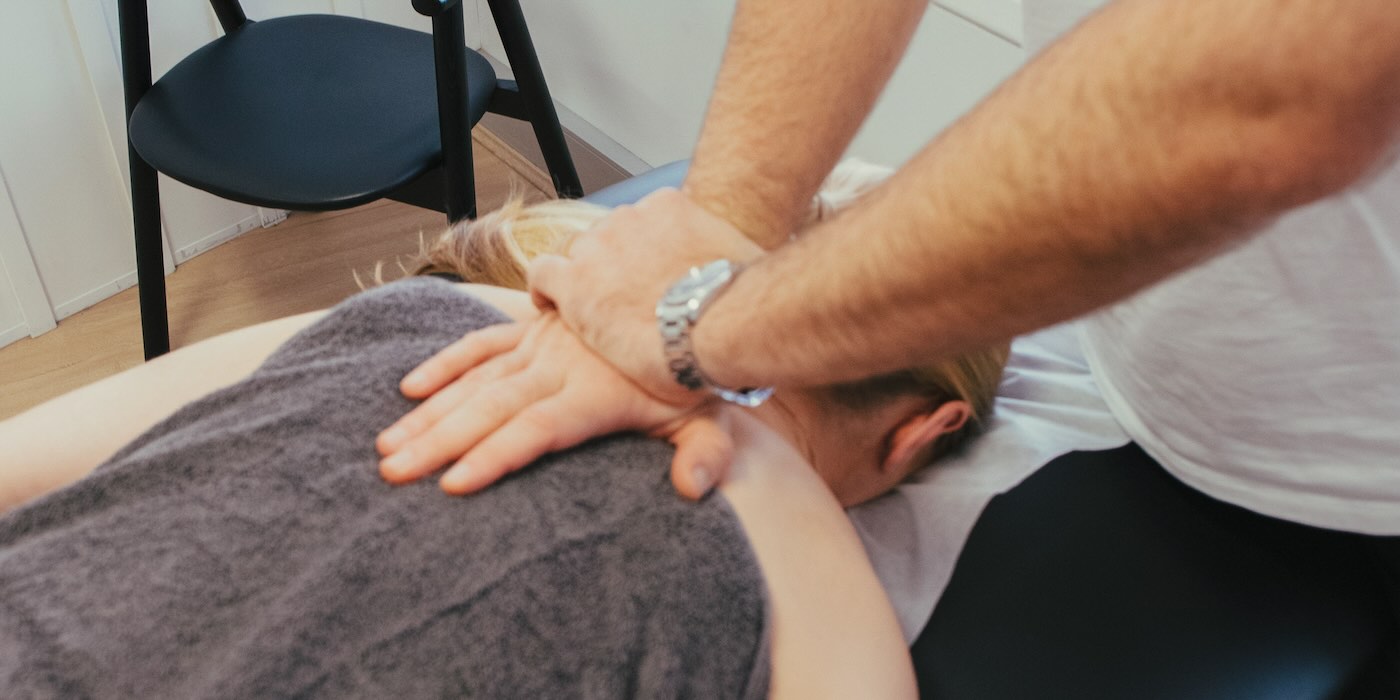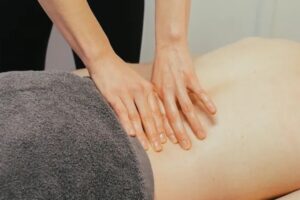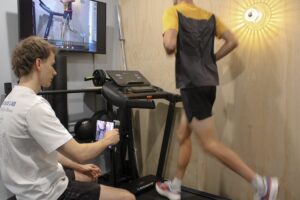The best physio exercises for TMJ include jaw relaxation exercises, chin tucks, and goldfish exercises to help relax jaw tension and strengthen and stretch the jaw muscles.
In over a decade as a physiotherapist, I’ve helped patients reduce neck pain using TMJ physio exercises such as chin tucks.
The right TMJ exercises, along with professional guidance, can relax the jaw and neck muscles to reduce pain and tension.
I’ve put together this list of my most recommended TMJ physio exercises for people looking to relieve TMJ pain and neck stiffness.
Quick Summary
1. Jaw Relaxation Exercise
2. Chin Tucks
3. Goldfish Exercises (Partial Opening)
4. Goldfish Exercises (Full Opening)
5. Resisted Mouth Opening
6. Resisted Mouth Closing
7. Side-to-Side Jaw Movement
8. Forward Jaw Movement
9. Sideways Resistance
10. Jaw Side Glides
11. Mandibular Stabilisation Exercise
Top 11 TMJ Physio Exercises
1. Jaw Relaxation Exercise
Did you know the temporomandibular joint (more simply known as the “jaw joint”) is the most used joint in the body? We are constantly using the jaw joint for talking, chewing, and breathing. It’s not surprising that the jaw joint can become fatigued, tense, overworked, and stiff.
Because the jaw muscles are connected to the neck muscles, jaw stiffness and tension can strain and tighten the neck muscles.
This jaw relaxation exercise is one of the TMJ physio exercises I recommend most for relieving jaw tension and neck stiffness. My patients often tell me how much they enjoy this exercise because of the instant relaxation it offers.
Some cracking and popping sounds are normal during this exercise but always stop if you feel pain.
Note: Before beginning any exercise program, always get clearance from your healthcare provider.
Intended benefits:
- Relieve pain
- Promote relaxation of the jaw muscles
- Reduce tightness and tension around the jaw and neck
How to do jaw relaxation exercises:
- Allow your tongue to rest on the roof of your mouth in the back of your upper front teeth
- Relax your jaw muscles and allow your teeth to gently come apart
- Slowly open your mouth to a comfortable position
- Close your mouth to return to the starting position
- Repeat 10 to 20 times
2. Chin Tucks
Chin tucks are one of the best TMJ physio exercises for relieving jaw pain and neck stiffness. This simple exercise involves maintaining good head and neck posture as you tuck your chin toward your chest.
Chin tucks offer a wonderful stretch for the jaw area without needing to open the mouth. If you experience discomfort when opening your mouth, this exercise may be an ideal option for you.
Intended benefits:
- Relieve TMJ pain
- Promote better posture
- Reduce tension and stiffness in the jaw muscles
How to do chin tucks:
- Sit or stand with good posture (chest up, shoulders back, head forward)
- Pull your head back to retract your chin back and down toward your chest (my patients find it helpful to imagine purposely creating a double chin)
- Hold for three seconds and return to the starting position
- Repeat 10 times
3. Goldfish Exercises (Partial Opening)
Goldfish exercises (partial opening) are another excellent TMJ exercise. This move helps relieve TMJ pain through gentle motions. It mimics the motion a goldfish makes when opening and closing its mouth.
Intended benefits:
- Increase the jaw’s range of motion
- Decrease jaw joint stiffness
- Relax the jaw muscles
- Improve the ability for the jaw to move easily
How to do goldfish exercises (partial opening):
- Hold your tongue on the roof of your mouth
- Place one finger in front of your ear (this is approximately where your TMJ is located)
- Place your pointer or middle finger on your chin
- Allow your lower jaw to open about halfway before closing it
- There should be slight pressure but no pain during this move
- Repeat 6 times to make 1 set
- Complete 6 sets daily
- You can also do this exercise by placing a finger on each TMJ as you open your mouth partially and close it again
You May Also Like: Top 11 Neck Strengthening Exercises Our Physios Recommend
4. Goldfish Exercises (Full Opening)
The Goldfish exercise (full-opening) is similar to partial opening. Both of these TMJ physio exercises share the goal of relaxing the TMJ joint and improving mobility.
The aim is to open your mouth while keeping your jaw muscles relaxed and the tongue on the roof of your mouth.
Intended benefits:
- Relieve tension and pain in the TMJ
- Stretch and strengthen the jaw muscles
- Improve jaw mobility
- Ease tension and stiffness in the facial and neck muscles
How to do goldfish exercises (full opening):
- Press your tongue on the roof of your mouth
- Place one finger on your chin and one finger on your TMJ
- Open your mouth while maintaining a relaxed jaw and keeping your tongue on the roof of your mouth
- Close your mouth
- Repeat 6 times to make 1 set
- Complete 6 sets daily
5. Resisted Mouth Opening
Resisted mouth opening is another excellent way to help reduce TMJ pain and strengthen the jaw muscles.
Intended benefits:
- Strengthen muscles in the face and jaw
- Reduce jaw tension and stiffness
- Reduce TMJ pain
How to do resisted mouth opening:
- Sit or stand with your head and neck in a neutral position
- Place both index fingers under your chin
- Gently create resistance with your fingers as you try to open your mouth
- Hold for three to six seconds
- Slowly close your mouth
- Repeat 10 times.
6. Resisted Mouth Closing
Resisted closing of the mouth can also be used to help reduce TMJ pain and discomfort. Although fingers work well for this exercise, you may also use a resistance device if desired.
Intended Benefits:
- Strengthen the jaw muscles
- Reduce TMJ pain
- Reduce neck tension
- Reduce facial pain
How to do resisted mouth closing:
- Squeeze your chin using your index and thumb of your dominant hand
- As you place gentle pressure on your chin, close your mouth
- Repeat 10 times
7. Side-to-Side Jaw Movement
The side-to-side TMJ exercise can be performed sitting up or lying down and is a great mobility exercise for the jaw joint. It helps stretch the jaw muscles to reduce tension and discomfort.
Intended benefits:
- Stretch the jaw muscles
- Promote improved joint mobility
- Reduce TMJ discomfort
- Promote relaxed muscles and ease tension
How to do side to side jaw movement:
- Use a small object, such as a clean pen or wooden craft stick, and place it between your teeth
- Gently clench your teeth to hold the object in place
- Gently glide your jaw side to side while maintaining pressure on the object
- Repeat for several seconds
- Do this exercise once a day
8. Forward Jaw Movement
Forward jaw movement is an excellent exercise to help reduce pain and stiffness in the temporomandibular joint. This TMJ exercise works by gently stretching the jaw muscles to reduce tightness and tension.
Intended benefits:
- Gently stretch the jaw muscles
- Relieve TMJ pain
- Reduce tension in the jaw and neck muscles
How to do forward jaw movement:
- Sit or stand comfortably with good posture (head facing forward, shoulders back)
- Slightly open your mouth
- Gently shift your lower teeth forward until they are in front of your upper teeth
- Hold for 10 seconds
- Slowly return to the starting position
9. Sideways Resistance
Sideways resistance exercises for TMJ aim to strengthen the jaw muscles and improve jaw mobility.
Intended benefits:
- Strengthen the jaw muscles
- Help promote improved jaw mobility
- Reduce neck stiffness and tension
How to do sideways resistance:
- Put an ¼ inch object between your front teeth (a stacked tongue depressor is a good option)
- Slowly and gently move your jaw from side to side
- Return to the starting position
- Repeat 10 times several times a day
10. Jaw Side Glides
Jaw side glides may help improve strength and mobility in the jaw joint. This TMJ exercise may also help improve jaw alignment when completed regularly.
Intended benefits:
- Strengthen the jaw muscles
- Improve jaw mobility
- Relieve jaw pain
- Improve jaw alignment
How to do jaw side glides:
- Open your mouth slightly
- Place two fingers on the right side of your chin
- Gently push sideways against your chin
- Use your jaw muscles to resist the push
- Hold for 3 to 5 seconds
- Repeat on the left side
- Repeat 3 times on each side
11. Mandibular Stabilisation Exercise
This mandibular stabilisation exercise aims to promote better jaw bone alignment. It can also help improve jaw mobility to ease tension and promote better quality of life.
Intended benefits:
- Promote improved jaw alignment
- Help increase jaw mobility
- Relieve tension and stiffness in the jaw, face, and neck
How to do mandibular stabilisation exercise:
- Begin with your jaw in a relaxed, neutral position
- Hold your thumb on the base of your jaw in the area just below your chin
- Apply gentle pressure with your thumb as you open your mouth
- Repeat the motion, making a point to place your thumb on the right and left side of your jaw
- Repeat 10 times total to complete a set
- Do up to 5 sets a day
When to See a Physio for TMJ
You may want to see a physio for TMJ if you:
- Experience persistent jaw from TMJ
- Have jaw pain that isn’t responding to home treatments
- Struggle to fully open or close your mouth due to pain or limited jaw mobility
- Hear popping or clicking sounds in your jaw
- Have jaw pain that is decreasing your quality of life or progressively getting worse
- Have pain that radiates to other areas, such as your ears, face, or neck
- Experience headaches associated with your jaw pain
- Grind your teeth at night (bruxism)
Other TMJ Pain Relief Measures
Along with asking your healthcare provider about TMJ physio exercises, other TMJ pain relief measures include:
- Over-the-counter pain medications, such as acetaminophen or ibuprofen
- Custom mouth guards to prevent jaw clenching and teeth grinding
- Warm or cold compresses applied to sore areas of the jaw
- Avoidance of nail-biting, gum chewing, teeth clenching, and biting the lower lip
- Orthodontic treatment to realign the jaw
- Stress-relieving techniques to help reduce jaw tension
- Practicing good posture
- Eating a diet focused on soft foods
- Avoiding chewy foods (taffy, caramels, etc.) and hard foods
- Limiting movements, such as singing or yawning, that stretch the jaw wide
Book a TMJ Physio Appointment
TMJ pain is a complex condition but the right exercises, lifestyle changes, and professional treatment can help manage it.
We created our TMJ physio treatments to help manage jaw and neck pain associated with TMJ. Our experienced physiotherapists create tailored programs that help restore pain-free movement and optimal jaw function.
If you are seeking relief from jaw or neck pain or aiming to prevent future issues, we invite you to book a TMJ physio appointment with our caring team
